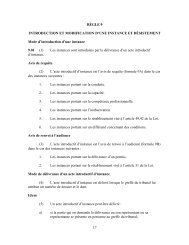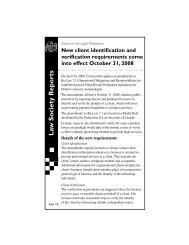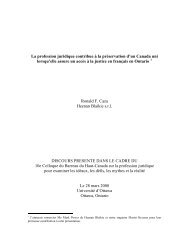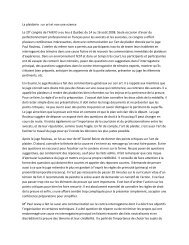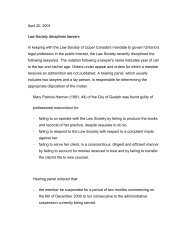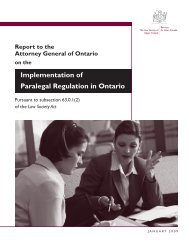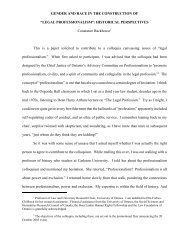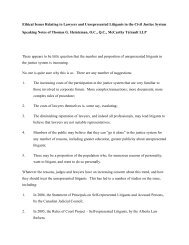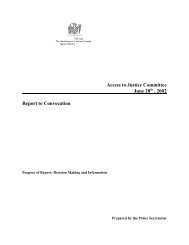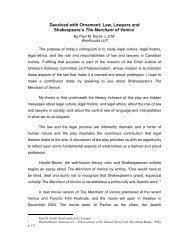Lawyers in a World Criminal Court - The Law Society of Upper Canada
Lawyers in a World Criminal Court - The Law Society of Upper Canada
Lawyers in a World Criminal Court - The Law Society of Upper Canada
Create successful ePaper yourself
Turn your PDF publications into a flip-book with our unique Google optimized e-Paper software.
LAWYERS IN A WORLD CRIMINAL COURTTribunal, and a commitment to the “public <strong>in</strong>terest”, difficult as it was to identify who was meant by the“public”, let alone how its <strong>in</strong>terests would be best served. 16What I would like to explore further here is the difference between a position that is <strong>in</strong>correct andone that is unpr<strong>of</strong>essional. <strong>The</strong>re are many <strong>in</strong>structive comments on that question <strong>in</strong> the recent decision <strong>of</strong>the Ontario <strong>Court</strong> <strong>of</strong> Appeal <strong>in</strong> R.v. Felderh<strong>of</strong>, an action aga<strong>in</strong>st a former senior <strong>of</strong>ficer <strong>of</strong> Bre-X M<strong>in</strong>eralsLtd. for <strong>in</strong>sider trad<strong>in</strong>g and authoriz<strong>in</strong>g or acquiesc<strong>in</strong>g <strong>in</strong> mislead<strong>in</strong>g press statements. 17 <strong>The</strong> dispute aroseover the disclosure <strong>of</strong> documents by the Prosecution. Rosenberg J.A. described Felderh<strong>of</strong> as a “complexcase <strong>in</strong>volv<strong>in</strong>g experienced counsel who took very different views about the role <strong>of</strong> the prosecutor and therules <strong>of</strong> evidence”. 18 He emphasized that “[i]t is a very serious matter to make allegations <strong>of</strong> impropermotives or bad faith aga<strong>in</strong>st any counsel”. 19International Tribunal;(g) not to be compelled to testify aga<strong>in</strong>st himself or to confess guilt.16In harmony with the purpose <strong>of</strong> its found<strong>in</strong>g resolution, the ICTY's mission is fourfold:• to br<strong>in</strong>g to justice persons allegedly responsible for serious violations <strong>of</strong> <strong>in</strong>ternationalhumanitarian law• to render justice to the victims• to deter further crimes• to contribute to the restoration <strong>of</strong> peace by promot<strong>in</strong>g reconciliation <strong>in</strong> the former Yugoslavia,onl<strong>in</strong>e: United Nations .17[ 2003] O.J. 4819.18 Ibid. at para. 86.19 Ibid. at para 93.1 - 6
LAWYERS IN A WORLD CRIMINAL COURTI would like to refer at some lenght to a case I dealt with at the ICTY, which, <strong>in</strong> my view, illustratesthe very danger <strong>of</strong> confus<strong>in</strong>g lack <strong>of</strong> pr<strong>of</strong>essionalism with the tak<strong>in</strong>g <strong>of</strong> an erroneous position on the law,or on its application. At the end, my po<strong>in</strong>t will be simply this: there is a vast difference between be<strong>in</strong>g wrongand be<strong>in</strong>g unpr<strong>of</strong>essional. If advanc<strong>in</strong>g vigourously a proposition that is eventually held to be <strong>in</strong>correct wereunpr<strong>of</strong>essional, there would not be many litigators left. What then are the boundaries between correctnessand pr<strong>of</strong>essionalism? Outside civility and decorum, when is conduct properly characterized asunpr<strong>of</strong>essional? My own experience suggests that the boundaries between the two are particularly blurred<strong>in</strong> a crim<strong>in</strong>al practice before an <strong>in</strong>ternational court, if only because the backgrounds and expectations <strong>of</strong>all <strong>in</strong>volved are pr<strong>of</strong>oundly different and because the play<strong>in</strong>g field is still <strong>in</strong>sufficiently def<strong>in</strong>ed.<strong>The</strong> case that most dramatically illustrates this po<strong>in</strong>t is Prosecutor v. Anto Furundzija, a judgment<strong>of</strong> a Trial Chamber <strong>of</strong> ICTY rendered Dec 10, 1998. 20 <strong>The</strong> accused, Furundzija, was found guilty on thefollow<strong>in</strong>g two counts: a) torture 21 and b) outrages upon personal dignity <strong>in</strong>clud<strong>in</strong>g rape, as violations <strong>of</strong> thelaws and customs <strong>of</strong> war, contrary to Article 3 <strong>of</strong> the ICTY Statute. 22 He was found to be a coperpetrator<strong>in</strong> torture and an aider and abettor to the rape.20(1998), Case No. IT-95-17/1 (International Crim<strong>in</strong>al Tribunal for the Former Yugoslavia, Trial Chamber II),onl<strong>in</strong>e: United Nations .21 Ibid. at para. 269.22 Ibid at para. 275.1 - 7
LAWYERS IN A WORLD CRIMINAL COURT<strong>The</strong> Trial Chamber found that the accused was a commander <strong>in</strong> a unit <strong>of</strong> the “HVO”, the armedforces <strong>of</strong> the Croatian Community <strong>of</strong> Herzeg-Bosna, known as “<strong>The</strong> Jokers”. 23 <strong>The</strong> pr<strong>in</strong>cipal witnessaga<strong>in</strong>st the accused was Witness A, whose identity was protected by court order. She was described <strong>in</strong>the judgement as “a married woman <strong>of</strong> Bosnian Muslem orig<strong>in</strong>”. 24 She was the subject <strong>of</strong> extensive sexualabuse, not all <strong>of</strong> it at the hands <strong>of</strong> the accused. 25 <strong>The</strong> conviction rested on specific allegations that WitnessA was sexually assualted by another soldier while be<strong>in</strong>g questionned by the accused at the headquarters<strong>of</strong> the Jokers (torture), and was forced to have oral and vag<strong>in</strong>al <strong>in</strong>tercourse with another man (a coaccusedwho was not yet arrested and therefore whose identity was not made public), while the accusedFurundzija was present and failed to <strong>in</strong>tervene.Between the first court appearance <strong>of</strong> the accused and the commencement <strong>of</strong> the trial, severalmotions were filed by both the prosecution and the defence, essentially deal<strong>in</strong>g with dislocure and witnessprotection issues. <strong>The</strong>se were constant areas <strong>of</strong> tension <strong>in</strong> pre-trial procedures at the ICTY. <strong>The</strong>prosecution has extensive disclosure obligations under the Rules. 26 Under Rule 68, “[t]he Prosecutor shall,as soon as practicable, disclose to the defence the existence <strong>of</strong> material known to the Prosecutor which<strong>in</strong> any way tends to suggest the <strong>in</strong>nocence or mitigate the guilt <strong>of</strong> the accused or may affect the credibility23 Ibid. at para. 65.24 Ibid. at para. 70.25 Ibid. at para. 89.26 <strong>The</strong> Rules, supra note 7.1 - 8
LAWYERS IN A WORLD CRIMINAL COURT<strong>of</strong> prosecution evidence.” Under Rule 66(A)(ii), it must provide the defence copies <strong>of</strong> statements <strong>of</strong> allwitnesses it <strong>in</strong>tedns to call at trial no later than 60 days before the date set for trial. 27 <strong>The</strong> parties <strong>of</strong> coursemay apply to the court to be relieved <strong>of</strong> some <strong>of</strong> these obligations. 28In the course <strong>of</strong> the many motions deal<strong>in</strong>g essentially with disclosure issues that were dealt with <strong>in</strong>that case, <strong>in</strong> a rul<strong>in</strong>g <strong>in</strong> early June <strong>of</strong> 1998, the Trial Chamber declared that “it was appalled by what itconsidered to be conduct close to negligence <strong>in</strong> the Prosecution’s preparation <strong>of</strong> the case” 29 On June 5,the Trial Chamber issued a “Formal Compla<strong>in</strong>t” to the Prosecutor concern<strong>in</strong>g the conduct <strong>of</strong> theProsecution. On June 8, I, as Prosecutor, acknowledged the compla<strong>in</strong>t and undertook to <strong>in</strong>vestigate thematter. 30 I asked the Deputy Prosecutor to compile the entire file regard<strong>in</strong>g the disclosure process <strong>in</strong> thecase.Under the Rules <strong>of</strong> the tribunal, there was <strong>of</strong> course no such th<strong>in</strong>g as a “Formal Compla<strong>in</strong>t” by aTrial Chamber to the Prosecutor, nor any mechanism to respond to it. June 1998 was not a good monthfor the Prosecutor. <strong>The</strong> declaration, by the Trial Chamber, that the trial team’s conduct <strong>in</strong> the Furundzija27 Rule 66(A)(ii), supra note 11.28 <strong>The</strong> Rules, supra note 7 at Rule 66 (C).29 <strong>The</strong> history <strong>of</strong> the disputes over disclosure <strong>of</strong> documents is summarised <strong>in</strong> Prosecutor v. AntoFurundzija, supra note 20 at para. 15.30 <strong>The</strong> Prosecutor v. Anto Furundzija, “Prosecutor’s Response to the Formal Compla<strong>in</strong>t <strong>of</strong> the TrialChamber issued on 5 June 1998" (11 December 1998), Case No. IT-95-17/1 (International Crim<strong>in</strong>al Tribunal for theFormer Yugoslavia, Trial Chamber ) at para. 2.1 - 9
LAWYERS IN A WORLD CRIMINAL COURTcase was “close to negligence” was disturb<strong>in</strong>g enough. This declaration had been made without notice tothe lawyers <strong>in</strong>volved, one American and one British, with no opportunity to respond to the allegations, andno right <strong>of</strong> appeal aga<strong>in</strong>st them.On June 8, 1998, the trial began. Prosecution counsel were under considerable stress, aggravatedby the pronouncement made aga<strong>in</strong>st them a few weeks earlier. <strong>The</strong> prosecution case was narrow andfocused. It lasted only four days. Several motions were argued after the close <strong>of</strong> the Prosecution’s case;the defence began to present its case on June 15, last<strong>in</strong>g a day and a half. On consent, and as wascontemplated by the Rules, 31 sentenc<strong>in</strong>g matters were also addressed before the close <strong>of</strong> the case. <strong>The</strong>hear<strong>in</strong>gs closed and judgement was reserved on June 22.Shortly after the close <strong>of</strong> hear<strong>in</strong>gs, I left for <strong>Canada</strong> on a short holiday. I soon received a phonecall from the Deputy Prosecutor. He had just found out that <strong>in</strong> the Furunzdija case, we had not disclosedto the Defence a redacted certificate and a statement from a psychologist at the Medica Women’s <strong>The</strong>rapyCenter <strong>in</strong> Bosnia 32 concern<strong>in</strong>g treatment that Witness A had received at the Center after the events <strong>in</strong> issue<strong>in</strong> the case.I decided that we had to notify the Defence <strong>of</strong> the existence <strong>of</strong> the documentary evidence and <strong>of</strong>arguments.”31 <strong>The</strong> Rules, supra note 7 at Rule 86(C): “<strong>The</strong> parties shall also address matters <strong>of</strong> sentenc<strong>in</strong>g <strong>in</strong> clos<strong>in</strong>g32 <strong>The</strong> Medica Center specializes <strong>in</strong> help<strong>in</strong>g women and children recover from wartime atrocities.1 - 10
LAWYERS IN A WORLD CRIMINAL COURTour position that it was not admissible <strong>in</strong> any event because its prejudicial effect outweighed its probativevalue, and we should seek a rul<strong>in</strong>g to that effect from the Trial Chamber. <strong>The</strong> defence immediately movedto strike the evidence <strong>of</strong> Witness “A” <strong>in</strong> light <strong>of</strong> what it alleged was misconduct on the part <strong>of</strong> theProsecution. On July 16, the Trial Chamber found that there had been serious misconduct on the part <strong>of</strong>the prosecution <strong>in</strong> breach <strong>of</strong> Rule 68, and it ordered the case re-opened. 33 It ordered the Prosecution todisclose to the Defence the content <strong>of</strong> the Medica documents and a re-call and re-exam<strong>in</strong>ation <strong>of</strong> anyProsecution witnesses, <strong>in</strong>clud<strong>in</strong>g Witness A, but only on issues aris<strong>in</strong>g out <strong>of</strong> the disclosed documents. Inaddition, the Defence was given leave to tender evidence, <strong>in</strong>clud<strong>in</strong>g expert evidence, to address “the issuesconcern<strong>in</strong>g any medical, psychiatric or psychological treatment or counsell<strong>in</strong>g that may have been receivedby Witness A” or any other issue related to the documents. 34In its July 16 Decision, the Trial Chamber reviewed the Response <strong>of</strong> the Prosecution to the Motionpresented by the Defence. 35 <strong>The</strong> Prosecution stated the decision to withold disclosure was made by one<strong>of</strong> the Trial Attorneys resposible for the case,on the basis <strong>of</strong> a pr<strong>of</strong>essional assessment <strong>of</strong> its content. Thatattorney concluded that “there was noth<strong>in</strong>g about the material which dist<strong>in</strong>guished Witness A’s conditionfrom any other rape victim” and that disclosure <strong>of</strong> the medical evidence would have been “a gross <strong>in</strong>vasion33 Prosecutor v. Anto Furundzija (1998), Case No. IT-95-17/1-T (International Tribunal for the FormerYugoslavia, Trial Chamber) at para. 16.34 Ibid. at para. 21.35 Ibid. at paras. 10-15.1 - 11
LAWYERS IN A WORLD CRIMINAL COURT<strong>of</strong> the witness’ privacy”. 36 <strong>The</strong> Response stated that the decision was “not made <strong>in</strong> bad faith for animproper purpose, or to ga<strong>in</strong> a tactical advantage”. 37 Nevertheless, the Trial Chamber held that there hadbeen “serions misconduct” on the part <strong>of</strong> the prosecution. 38 “<strong>The</strong> material clearly had the potential effectto affect the credibility <strong>of</strong> the prosecution evidence” 39 and its existence should have been disclosed. In theconclud<strong>in</strong>g paragraphs, the Trial Chamber held that there had been “a serious procedural error” on the part<strong>of</strong> the Prosecution. 40<strong>The</strong> case reopened on November 9, 1998 . Expert evidence was tendered by both parties on theeffect <strong>of</strong> Post-Traumatic Stress Disorder on memory and Witness A was recalled. Judgement was aga<strong>in</strong>reserved and a conviction was entered on December 10, 1998. 41 <strong>The</strong> next day, I filed my response to theFormal Compla<strong>in</strong>t issued by the Trial Chamber on June 5. I stated at the outset that:...any Prosecutor required to respond to the f<strong>in</strong>d<strong>in</strong>gs <strong>of</strong> a <strong>Court</strong> is immediately placed <strong>in</strong>a difficult position. That difficulty is exacerbated <strong>in</strong> this <strong>in</strong>stance, s<strong>in</strong>ce the absence <strong>of</strong>established precedent and settled procedure makes it unclear to what extent the TrialChamber’s f<strong>in</strong>d<strong>in</strong>gs and its categorisation <strong>of</strong> the conduct <strong>in</strong> question are to be regardedas conclusive.36 Ibid. at para. 10.37 Ibid.38 Ibid. at para. 16.39 Ibid. at para. 17.40 Ibid. at para. 20.41 Prosecutor v. Anto Furundzija, supra note 20.1 - 12
LAWYERS IN A WORLD CRIMINAL COURTAs Prosecutor, I have responsibility for the conduct <strong>of</strong> this case. <strong>The</strong> criticismsvoiced <strong>in</strong> the Formal Compla<strong>in</strong>t relate to two dist<strong>in</strong>guishable types <strong>of</strong> conduct, namely,the conduct <strong>of</strong> prosecution counsel as advocates, and the conduct <strong>of</strong> “the prosecution”as a party to the proceed<strong>in</strong>gs. <strong>The</strong> former concerns the behaviour <strong>of</strong> <strong>in</strong>dividuals appear<strong>in</strong>g<strong>in</strong> court. It relates to their obligations and duties as <strong>of</strong>ficers <strong>of</strong> the courts and <strong>of</strong> the law.Typically the sanctions for breach <strong>of</strong> those duties and responsibilities lie with pr<strong>of</strong>essionalassociations, with discipl<strong>in</strong>ary bodies, and <strong>in</strong> certa<strong>in</strong> circumstances with<strong>in</strong> the contemptpowers <strong>of</strong> the court itself. Responsibility <strong>in</strong> the latter sense is not the responsibility <strong>of</strong><strong>in</strong>dividuals, but relates to the conduct <strong>of</strong> the party qua litigant. Failure by a party toobserve legal rules is visited with different sanctions. Rule 5(C) <strong>of</strong> the Tribunal’s Rules <strong>of</strong>Procedure and Evidence reflects the pr<strong>in</strong>ciple that appropriate relief should be granteddur<strong>in</strong>g the course <strong>of</strong> the proceed<strong>in</strong>gs. Such sanctions provide a complete andproportionate remedy for the non-compliance <strong>in</strong> question. Examples are refusal toenterta<strong>in</strong> late motions, exclusion <strong>of</strong> evidence, with the ultimate sanction aga<strong>in</strong>st the mov<strong>in</strong>gparty be<strong>in</strong>g to halt or dismiss the proceed<strong>in</strong>gs themselves. While the term “misconduct”can be applied to conduct <strong>of</strong> the first k<strong>in</strong>d call<strong>in</strong>g for additional corrective measures, it isless pat to describe those failures <strong>of</strong> a party for which failures the legal system itselfprovides remedies to avoid miscarriage <strong>of</strong> justice. In the context <strong>of</strong> this compla<strong>in</strong>t, Ibelieve that my responsibility is to advance the case for the prosecution <strong>in</strong> accordancewith the law, and to do so through competent, pr<strong>of</strong>essional counsel. 42Had the Prosecution committed “a serious procedural error” <strong>in</strong> not disclos<strong>in</strong>g the Medicadocuments, or had there been “serious misconduct” on the part <strong>of</strong> the Prosecution? <strong>The</strong> Trial Chamberfound both and seemed to use both expressions <strong>in</strong>terchangeably. In my view “procedural error” and“serious misconduct” refer to two different concepts: the former, is an error <strong>of</strong> law; the latter, a f<strong>in</strong>d<strong>in</strong>g <strong>of</strong>pr<strong>of</strong>essional misconduct.We sought advice on that po<strong>in</strong>t from the President <strong>of</strong> the International Association <strong>of</strong> Prosecutors,30 at paras. 6-7.42 “Prosecutor’s Response to the Formal Compla<strong>in</strong>t <strong>of</strong> the Trial Chamber issued on 5 June 1998", supra note1 - 13
LAWYERS IN A WORLD CRIMINAL COURTMr. Eamonn Barnes. 43 He advised that we contact the Crown Office <strong>of</strong> Scotland, where there is one <strong>of</strong>the world’s longest stand<strong>in</strong>g systems <strong>of</strong> public prosecution that draws upon both common law andcont<strong>in</strong>ental traditions. <strong>The</strong> Lord Advocate and the Crown Agent <strong>of</strong> Scotland gave an <strong>in</strong>dependentassessment <strong>of</strong> the conduct <strong>of</strong> the prosecution on the explicit understand<strong>in</strong>g that we would make the f<strong>in</strong>d<strong>in</strong>gspublic, which we did <strong>in</strong> fil<strong>in</strong>g the response to the Formal Compla<strong>in</strong>t. <strong>The</strong>y found an error <strong>of</strong> judgment <strong>in</strong>not disclos<strong>in</strong>g, but no pr<strong>of</strong>essional misconduct.In draft<strong>in</strong>g my response to the “Formal Compla<strong>in</strong>t” made by the Trial Chamber aga<strong>in</strong>st theProsecution, I decided to go further to address the July 1998 Decision <strong>of</strong> the Chamber that characterisedthe decision not to disclose Witness A’s Medica documents to the Defence as “serious misconduct”. 44This decision regard<strong>in</strong>g evidence document<strong>in</strong>g the psychological trauma suffered by Witness A as a result<strong>of</strong> severe sexual violence was made <strong>in</strong> a legal environment which had not resolved the contentious issuesaround disclosure <strong>of</strong> victim’s medical and psychological records. <strong>The</strong>se issues lie “at the cutt<strong>in</strong>g-edge <strong>of</strong>a develop<strong>in</strong>g body <strong>of</strong> jurisprudence concern<strong>in</strong>g the balanc<strong>in</strong>g <strong>of</strong> important compet<strong>in</strong>g public <strong>in</strong>terests.” 45Just how contentious is clear from the various amicus briefs by women’s groups subsequentlysubmitted on the disclosure <strong>of</strong> medical history <strong>of</strong> victims <strong>of</strong> sexual assault. In <strong>Canada</strong>, we have the benefit43 Director <strong>of</strong> Public Prosecutions <strong>of</strong> Ireland.30 at para. 20.44 “Prosecutor’s Response to the Formal Compla<strong>in</strong>t <strong>of</strong> the Trial Chamber issued on 5 June 1998", supra note45 Ibid. at para. 21.1 - 14
LAWYERS IN A WORLD CRIMINAL COURT<strong>of</strong> the Supreme <strong>Court</strong> <strong>of</strong> <strong>Canada</strong>’s decision <strong>in</strong> R. v. O’Connor 46 and subsequent amendments to theCanadian Crim<strong>in</strong>al Code. 47 By contrast, the Rules <strong>of</strong> the ICTY provided little or no assistance on theapproach to be taken <strong>in</strong> this <strong>in</strong>ternational jurisdiction.<strong>The</strong> Canadian experience is quite illustrative. It supports my argument that a decision not todisclose taken <strong>in</strong> good faith, on proper grounds, and represent<strong>in</strong>g an exercise <strong>of</strong> pr<strong>of</strong>essional judgment ona difficult and novel issue may constitute an error <strong>of</strong> judgment but certa<strong>in</strong>ly does not amount to“misconduct” by any accepted def<strong>in</strong>ition <strong>of</strong> that term. 48In R. v. O’Connor, a bishop and former pr<strong>in</strong>cipal <strong>of</strong> a residential school was charged with sexual<strong>of</strong>fences aga<strong>in</strong>st students and employees. At trial, O’Connor sought an order that the Crown access anddisclose the victims’ medical, counsell<strong>in</strong>g, and other personal records. When the Crown refused, the trialjudge issued a stay <strong>of</strong> proceed<strong>in</strong>gs that was overturned by the <strong>Court</strong> <strong>of</strong> Appeal. <strong>The</strong> case eventually camebefore the Supreme <strong>Court</strong> <strong>of</strong> <strong>Canada</strong>, and, as <strong>in</strong> the Furundzija case, a number <strong>of</strong> <strong>in</strong>terveners argued thatpersonal records should never be made available to the accused <strong>in</strong> crim<strong>in</strong>al sexual assault proceed<strong>in</strong>gs. 49<strong>The</strong> majority <strong>of</strong> the <strong>Court</strong> established a procedure for weigh<strong>in</strong>g the rights <strong>of</strong> the accused to a fair trial46 [1995] 4 S.C.R. 411.47 R.S. C. 1985, c. C-46, ss. 278.1-278.9.48 “Prosecutor’s Response to the Formal Compla<strong>in</strong>t <strong>of</strong> the Trial Chamber issued on 5 June 1998", supra note30 at para. 20.49 Jennifer Koshan, “Disclosure and Production <strong>in</strong> Sexual Violence Cases: Situat<strong>in</strong>g St<strong>in</strong>chcombe”, (2002) 40Alberta L. Rev. 655 at 659.1 - 15
LAWYERS IN A WORLD CRIMINAL COURTaga<strong>in</strong>st a third party’s right to privacy. This procedure placed the burden on the accused to establish therelevance <strong>of</strong> the records sought to be disclosed. If the accused succeeds on that po<strong>in</strong>t, the judge mustbalance the salutary and deleterious effects <strong>of</strong> production- whether deny<strong>in</strong>g the production “wouldconstitute a reasonable limit on the ability <strong>of</strong> the accused to make full answer and defence” 50 while tak<strong>in</strong>ga number <strong>of</strong> factors <strong>in</strong>to consideration, <strong>in</strong>clud<strong>in</strong>g the dignity, privacy, or security <strong>in</strong>terests <strong>of</strong> the third party.S<strong>in</strong>ce R. v. O’Connor, the Crim<strong>in</strong>al Code provisions deal<strong>in</strong>g with production <strong>of</strong> records <strong>in</strong> sexual<strong>of</strong>fences have come <strong>in</strong>to force, 51 expand<strong>in</strong>g the list <strong>of</strong> factors to be taken <strong>in</strong>to account before productionis ordered. Consideration must now be given to society’s <strong>in</strong>terest <strong>in</strong> report<strong>in</strong>g sexual <strong>of</strong>fences and <strong>in</strong>encourag<strong>in</strong>g counsell<strong>in</strong>g <strong>of</strong> survivors, and the effect <strong>of</strong> production on the <strong>in</strong>tegrity <strong>of</strong> the trial process. 52 <strong>The</strong>provisions were upheld as constitutional <strong>in</strong> R. v. Mills. 53<strong>The</strong> Canadian experience <strong>of</strong> lengthy pr<strong>of</strong>essional debate and “dialogue” between the <strong>Court</strong>s andParliament on the issue <strong>of</strong> disclosure <strong>of</strong> third party medical records <strong>in</strong> cases <strong>of</strong> sexual <strong>of</strong>fences emphasisesmy po<strong>in</strong>t that <strong>in</strong> the absence <strong>of</strong> direction, many Prosecutors would not have disclosed third party recordsto the defence and that action would not constitute misconduct. Indeed, Pr<strong>of</strong>essor Koshan <strong>of</strong> the University50 R. v. O’Connor, supra note 46 at para. 30.51Crim<strong>in</strong>al Code, supra note 47. <strong>The</strong> provisions came <strong>in</strong>to force on 12 May 1997.52 Ibid. at s. 278.5(2).53 [1999] 3 S.C.R. 668.1 - 16
LAWYERS IN A WORLD CRIMINAL COURT<strong>of</strong> Calgary, <strong>in</strong> a comprehensive survey <strong>of</strong> post Mills lower court decisions <strong>in</strong> production applications,concludes that there is still a great deal <strong>of</strong> variation <strong>in</strong> trial court decisions whether to order disclosure ornot because <strong>of</strong> the level <strong>of</strong> discretion that is left to trial judges who decide on the merits <strong>of</strong> production ona case-by-case basis. 54<strong>The</strong> Furundzija case came to ICTY three years after O’Connor was decided <strong>in</strong> <strong>Canada</strong>. <strong>The</strong>orig<strong>in</strong>al decision not to disclose the medical records <strong>of</strong> the victim <strong>in</strong> that case, and my subsequent overrul<strong>in</strong>g<strong>of</strong> that decision when it came to my attention, were made <strong>in</strong> a legal environment <strong>in</strong> which one <strong>in</strong>evitablydraws from one’s own legal tradition, and from a sense <strong>of</strong> pr<strong>of</strong>essional responsibility that is very much theproduct <strong>of</strong> that tradition. Some <strong>of</strong> us, work<strong>in</strong>g <strong>in</strong> the <strong>in</strong>ternational crim<strong>in</strong>al environment, were moreadversarial that others. Most <strong>of</strong> us automatically applied rules and followed practices that we werecomfortable with. Only when these attitudes and practices appeared strange to others, which was <strong>of</strong>ten,did we have to justify them.A small example. We had another trial <strong>in</strong>volv<strong>in</strong>g several accused. A prosecution witness wastestify<strong>in</strong>g <strong>in</strong> chief. At the lunch recess the witness told prosecution counsel that he recognized one <strong>of</strong> theaccused as one <strong>of</strong> the participants <strong>in</strong> the crime, which he had not been able to do beforehand. After lunch,the prosecutor <strong>in</strong>formed the defence and then proceeded to ask the witness if he could identify any <strong>of</strong> theaccused, which he did. <strong>The</strong> defence objected vigoroulsy on the basis <strong>of</strong> non-disclosure. When the court54 Koshan, supra note 49.1 - 17
LAWYERS IN A WORLD CRIMINAL COURTwas told <strong>of</strong> the circumstances, the defence claimed that the Prosecutor was <strong>in</strong> breach <strong>of</strong> rules <strong>of</strong>pr<strong>of</strong>essional conduct by speak<strong>in</strong>g to his own witness while the witness was still on the stand under oath.<strong>The</strong> court put the matter over to the next morn<strong>in</strong>g for submissions. <strong>The</strong> Rules, not surpris<strong>in</strong>gly, wereonce aga<strong>in</strong> silent on the desirability <strong>of</strong> speak<strong>in</strong>g to a witness while they were <strong>in</strong> the midst <strong>of</strong> theirexam<strong>in</strong>ation-<strong>in</strong>-chief. In the Office <strong>of</strong> the Prosecutor, we had a lively debate as to which practice we shouldadvocate, not only for this case, but as a precedent for the conduct <strong>of</strong> all cases. <strong>The</strong> views <strong>of</strong> lawyerstra<strong>in</strong>ed <strong>in</strong> common law systems, based on their own national pratices, ranged from: “ I would be disbarredif I did” to “ I would be disbarred if I didn’t”. <strong>The</strong> Canadians, <strong>of</strong> course, took the middle ground: “ It’s OKwhile the witness is <strong>in</strong> chief, but a no-no while he’s <strong>in</strong> cross”. Meanwhile the members <strong>of</strong> the team tra<strong>in</strong>ed<strong>in</strong> the civil law tradition are still try<strong>in</strong>g to figure out what the fuss was all about.Here, one would not consider these issues matters <strong>of</strong>”pr<strong>of</strong>esisonalism” but matters <strong>of</strong> law. In thecontext <strong>of</strong> the emerg<strong>in</strong>g discipl<strong>in</strong>e and practice <strong>of</strong> <strong>in</strong>ternational crim<strong>in</strong>al law, many procedural issues must,by default, be handled on the basis <strong>of</strong> a pr<strong>of</strong>essional sense <strong>of</strong> what the process is about and how justiceis better served. <strong>The</strong>re aga<strong>in</strong>, clashes <strong>of</strong> traditions and expectations come <strong>in</strong>to play, with the search for thetruth tolerat<strong>in</strong>g fewer procedural obstacles <strong>in</strong> some systems than <strong>in</strong> others.Accusations, or at least impressions <strong>of</strong> unpr<strong>of</strong>essionalism, are easily formed, and hard to dismiss.This is because our ethical responses are governed primarily by the legal framework with<strong>in</strong> which we1 - 18
LAWYERS IN A WORLD CRIMINAL COURToperate and then by the traditions which have come to constitute the “dos and dont’s” <strong>of</strong> our ownpr<strong>of</strong>essionnal lives.When we work <strong>in</strong> an <strong>in</strong>ternational context where the legal framework is by necessaity expressed<strong>in</strong> very general terms and where the tradition <strong>of</strong> practice is virtually non-existent, there is an almostirrisistible temptation to equate pr<strong>of</strong>essionalism with familiarity. If we do, and if we cannot br<strong>in</strong>g ourselvesto reth<strong>in</strong>k our position from first pr<strong>in</strong>ciples, we risk duplicat<strong>in</strong>g an environment similar to the one describedby Pr<strong>of</strong>essorf Backhouse <strong>in</strong> her paper last year. An environment dom<strong>in</strong>ated by the legal culture <strong>of</strong> thosewhose first language is English and whose legal system provides a ready-made answer to everyth<strong>in</strong>g. Wecan therefore export an idea <strong>of</strong> “pr<strong>of</strong>essionalism” that appears to equate pr<strong>of</strong>essionalism withsophistication but leaves little room for those who are seek<strong>in</strong>g the same justice but <strong>in</strong> a different way.Pr<strong>of</strong>essionalism by cultural hegemony is not a desirable formula for the development <strong>of</strong> an <strong>in</strong>dig<strong>in</strong>eous body<strong>of</strong> crim<strong>in</strong>al practice before <strong>in</strong>ternational courts.This is true <strong>of</strong> the pratice <strong>of</strong> prosecutors and <strong>of</strong> the expectations and rul<strong>in</strong>gs <strong>of</strong> judges. It is also true<strong>of</strong> the aspirations <strong>of</strong> the defence bar, which is still attempt<strong>in</strong>g to f<strong>in</strong>d its place <strong>in</strong> an environment where itsexistence <strong>in</strong> an organised form was systematically ignored. <strong>The</strong> International Crim<strong>in</strong>al Bar, created almostexclusively because <strong>of</strong> the vision and drive <strong>of</strong> Montreal lawyer, Elise Groulx, adopted at its GeneralAssembly <strong>in</strong> Berl<strong>in</strong> <strong>in</strong> March 2003 a “Code <strong>of</strong> Conduct and Discipl<strong>in</strong>ary Procedure” to apply to counsel1 - 19
LAWYERS IN A WORLD CRIMINAL COURTappear<strong>in</strong>g before the International Crim<strong>in</strong>al <strong>Court</strong>. 55 <strong>The</strong> Code was presented to the ICC <strong>in</strong> May <strong>of</strong> lastyear.It is not my purpose to comment on the content <strong>of</strong> any <strong>of</strong> the provisions <strong>of</strong> that Code <strong>of</strong> Conduct,but I was struck by the statement <strong>of</strong> objectives that was summarized <strong>in</strong> its presentation to the ICC asfollows:Our objective was to draft a Code <strong>of</strong> Conduct consistent with the Rome Statute <strong>of</strong> 1998and the Rules <strong>of</strong> Procedure and Evidence as well as with fundamental pr<strong>in</strong>ciples <strong>of</strong> thelegal pr<strong>of</strong>ession that could be accepted and followed by counsel from all cultures,traditions and legal systems and pr<strong>of</strong>essional backgrounds.This, <strong>in</strong> my view, is the challenge fac<strong>in</strong>g the pr<strong>of</strong>essional lawyer mov<strong>in</strong>g to a practice before an<strong>in</strong>ternational crim<strong>in</strong>al court, either as a judge, as prosecutor, or as defence counsel. <strong>The</strong>re is no dishonour<strong>in</strong> be<strong>in</strong>g wrong, assum<strong>in</strong>g one is otherwise diligent. I believe that we can safely promote <strong>in</strong>tegrity, honesty,and candour as universal trademarks <strong>of</strong> advocacy. If Canadians have anyth<strong>in</strong>g <strong>in</strong> particular to contributealong that l<strong>in</strong>e I would suggest that the will<strong>in</strong>gness to recognize errors and to correct them is the ultimateguarantee <strong>of</strong> justice. It should not be the hardest th<strong>in</strong>g for a true pr<strong>of</strong>essional to do, but it <strong>of</strong>ten is.Allow me a f<strong>in</strong>al example. In prepar<strong>in</strong>g my response to the Formal Compla<strong>in</strong>t lodged by the TrialChamber aga<strong>in</strong>st my Office <strong>in</strong> the Furundzija case, I debated with my colleagues how far we could go55 Code <strong>of</strong> Conduct & Discipl<strong>in</strong>ary Procedure, supra note 3.1 - 20
LAWYERS IN A WORLD CRIMINAL COURTand how frank we could be <strong>in</strong> criticis<strong>in</strong>g the court for hav<strong>in</strong>g <strong>in</strong>itiated the compla<strong>in</strong>t <strong>in</strong> that form <strong>in</strong> the firstplace. <strong>The</strong>re was no right <strong>of</strong> appeal from the allegations/f<strong>in</strong>d<strong>in</strong>gs conta<strong>in</strong>ed <strong>in</strong> the compla<strong>in</strong>t, nor was thereany procedure for anyone to respond to our decision to file a public response. We couched my response<strong>in</strong> the follow<strong>in</strong>g terms. I will let you be the judges <strong>of</strong> its “pr<strong>of</strong>essionalism”:Lastly, I must express my concern that the Trial Chamber chose to deliver, especially onthe eve <strong>of</strong> the trial, a public Formal Compla<strong>in</strong>t without any prior notice to me, andwithout hav<strong>in</strong>g given those personally affected an opportunity to make submissions. Allcourts possess an <strong>in</strong>herent right to control how cases proceed before them and tocriticise the parties appear<strong>in</strong>g before them. Yet such a Formal Compla<strong>in</strong>t as this isprovided for nowhere <strong>in</strong> the Rules <strong>of</strong> Procedure and Evidence, and may well be withoutprecedent <strong>in</strong> established domestic jurisdictions. If such a compla<strong>in</strong>t is <strong>in</strong>tended to beunanswerable, it is unfair; if it is meant to be answered, it must be made at an appropriatetime, when an opportunity to answer exists. I believe that my response is not timely, butI will urge the Judges <strong>of</strong> the Tribunal, as its collective rule-mak<strong>in</strong>g body to give seriousconsideration as to whether such a compla<strong>in</strong>t procedure should formally be <strong>in</strong>corporated<strong>in</strong>to the Tribunal’s procedural mechanisms or formally be disapproved. 56To my knowledge, neither was done.30 at para. 23.56 “Prosecutor’s Response to the Formal Compla<strong>in</strong>t <strong>of</strong> the Trial Chamber issued on 5 June 1998", supra note1 - 21
1 - 22LAWYERS IN A WORLD CRIMINAL COURT



